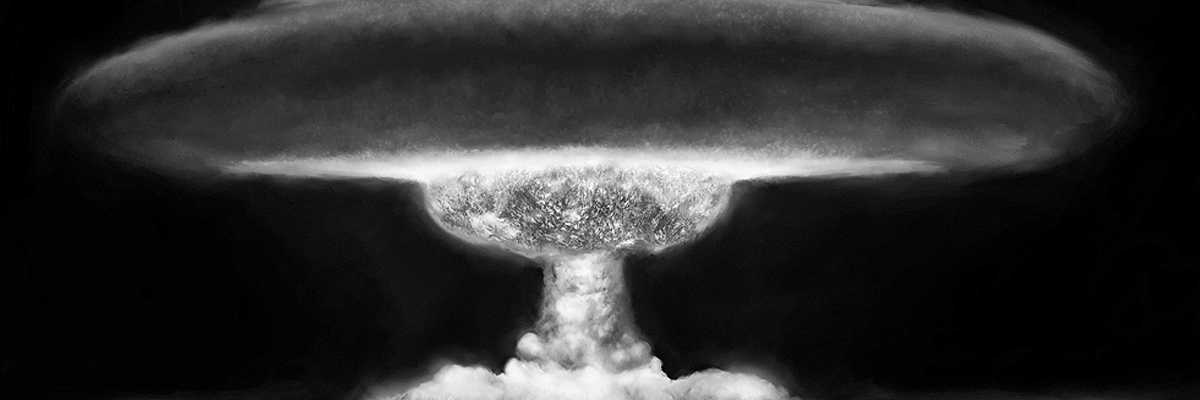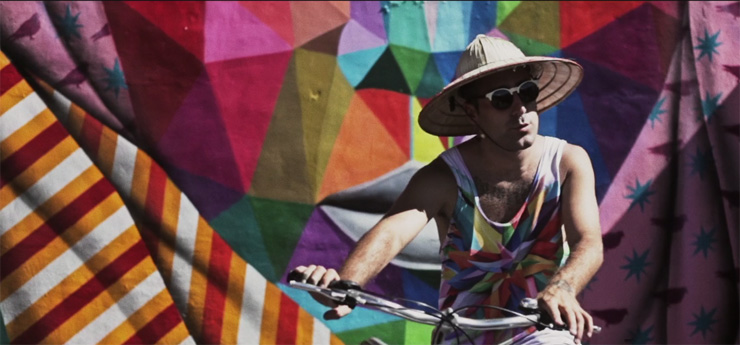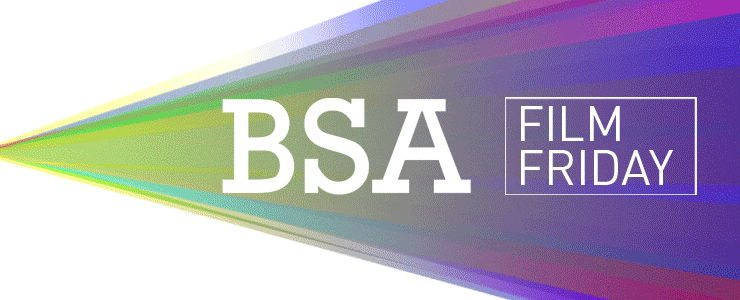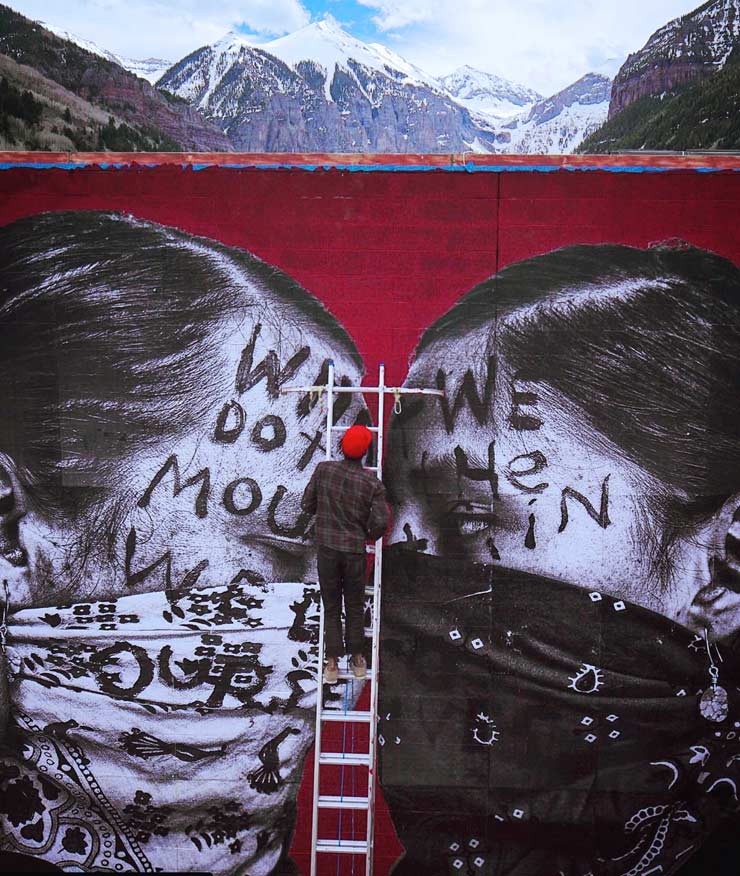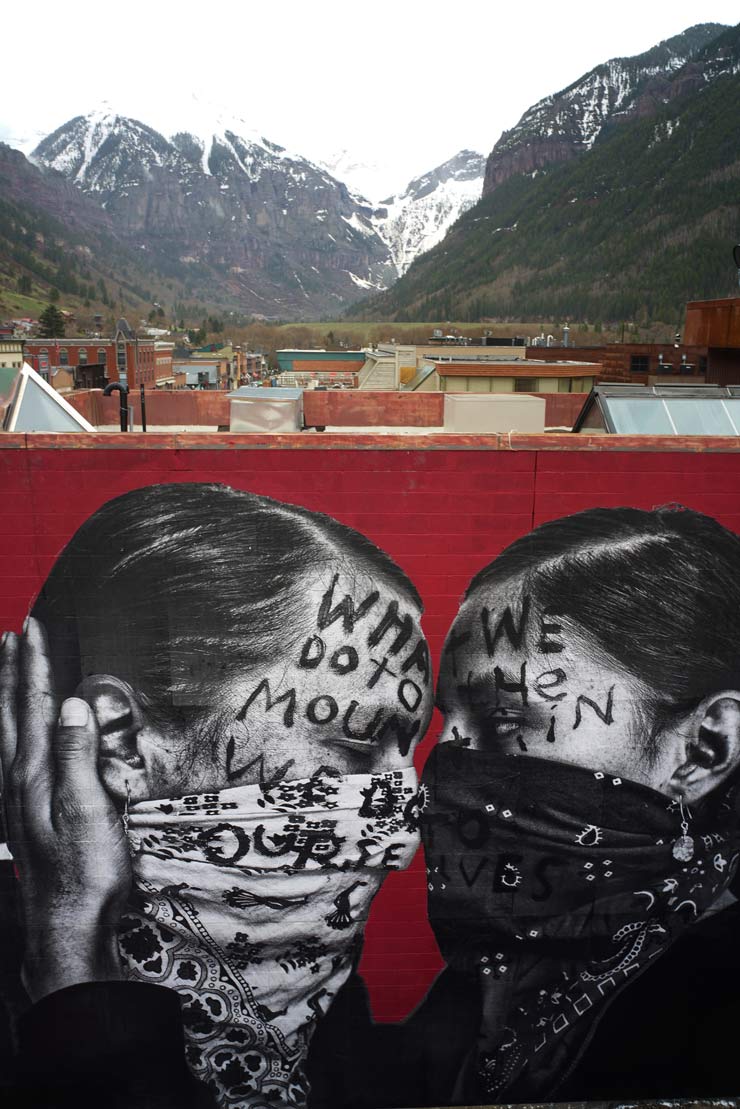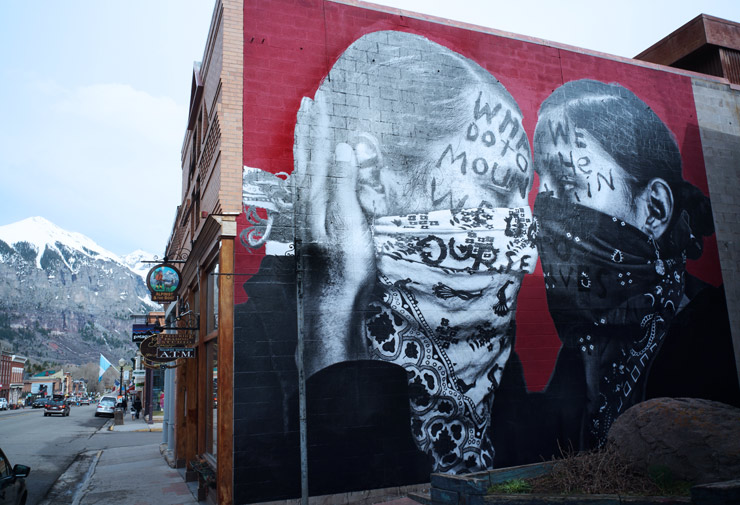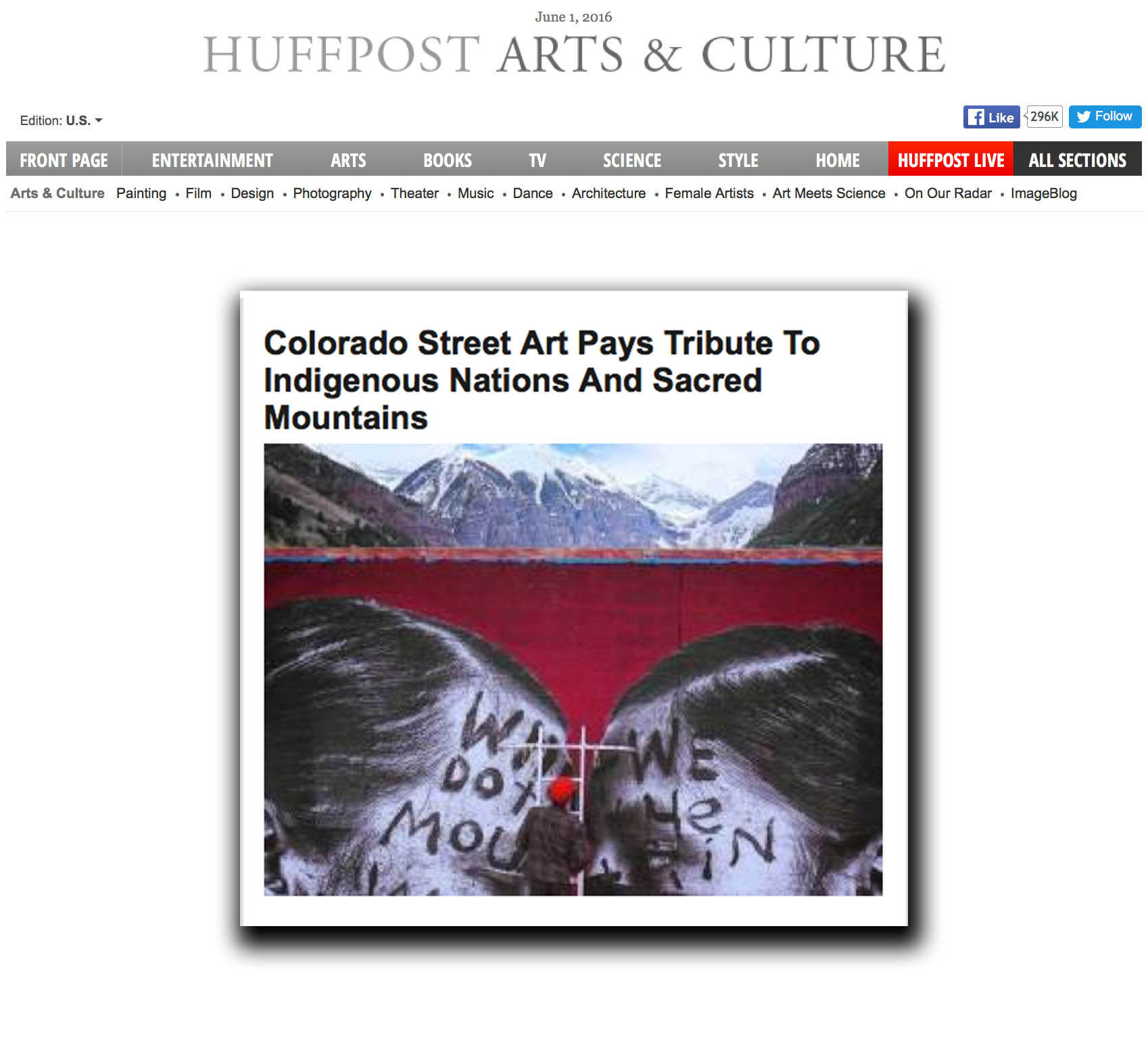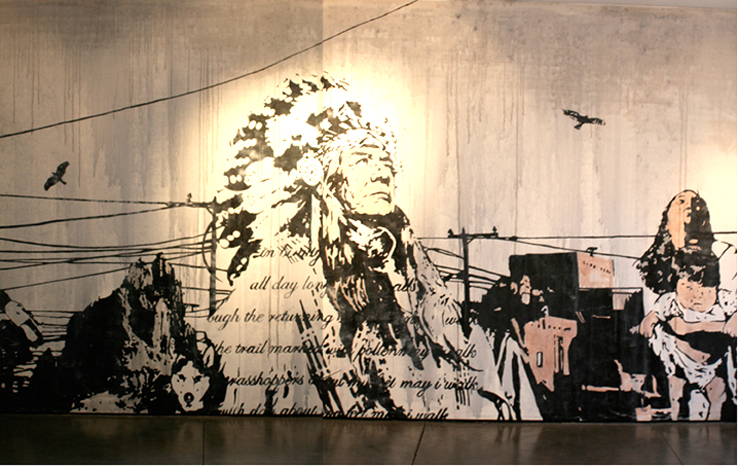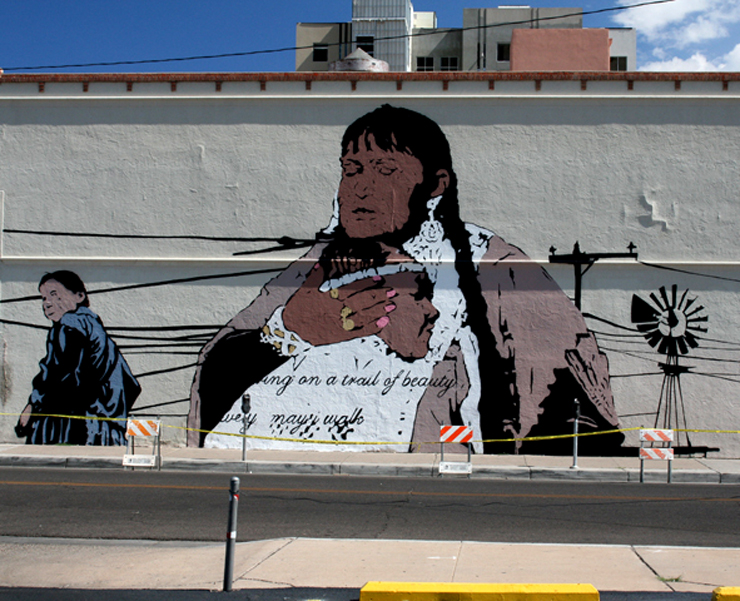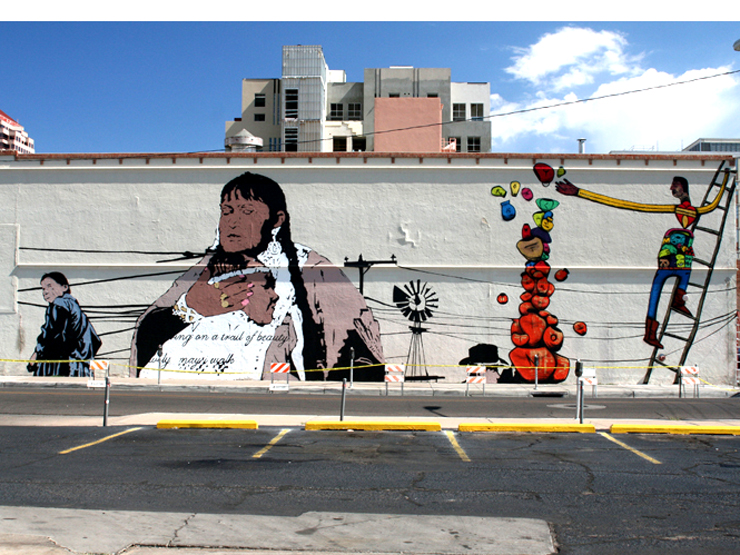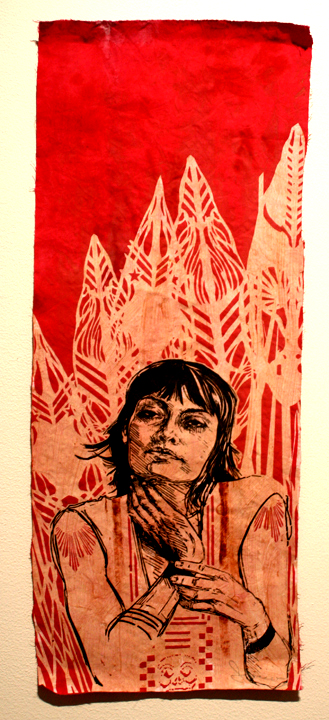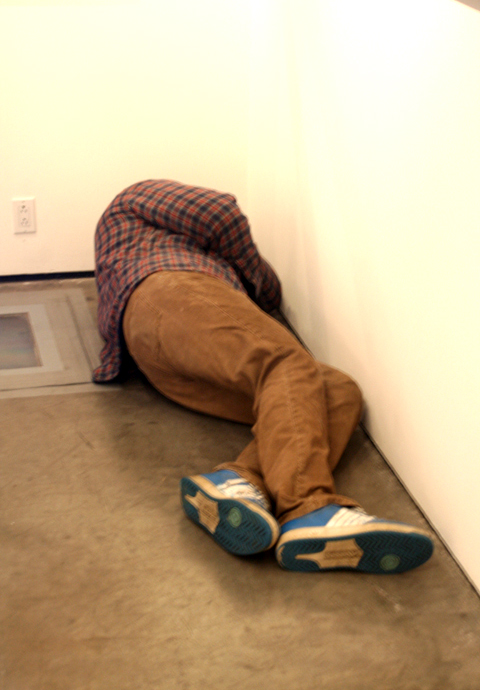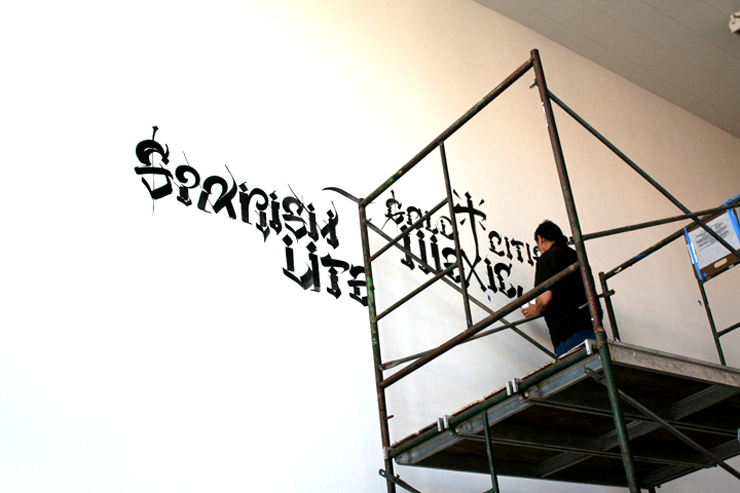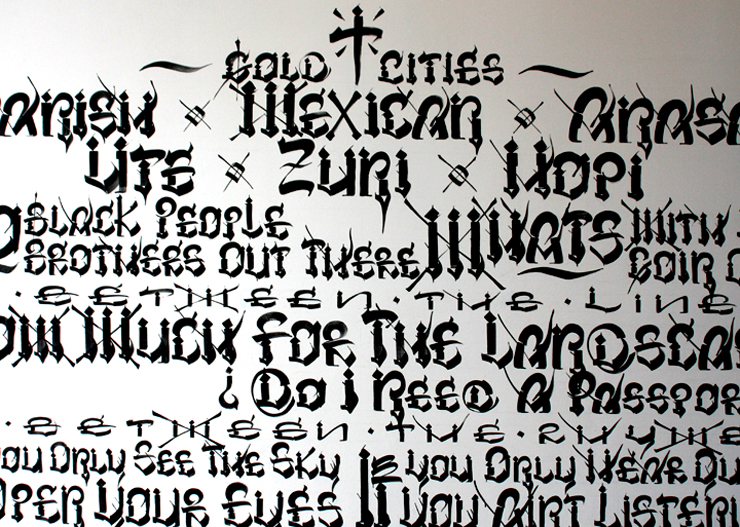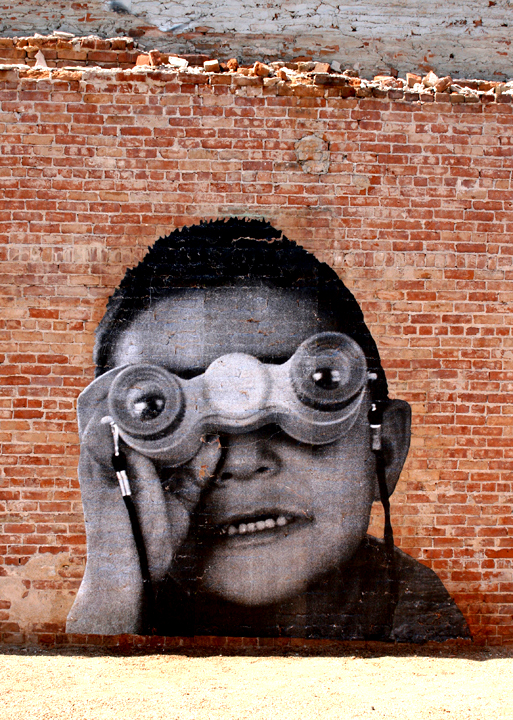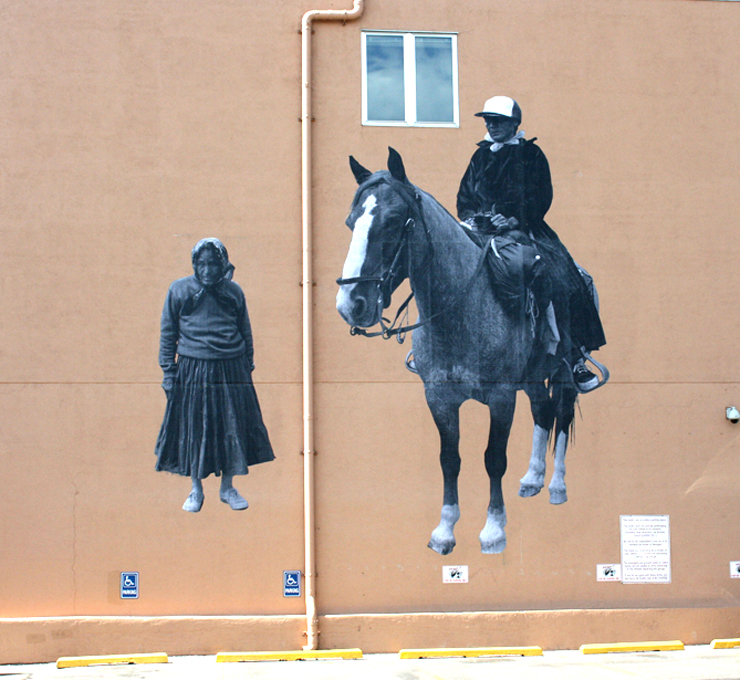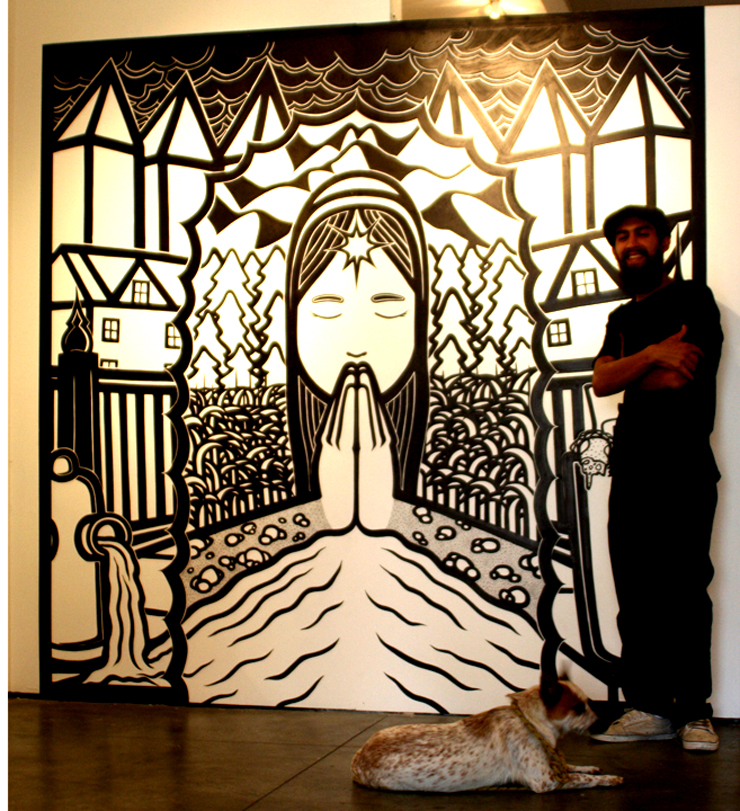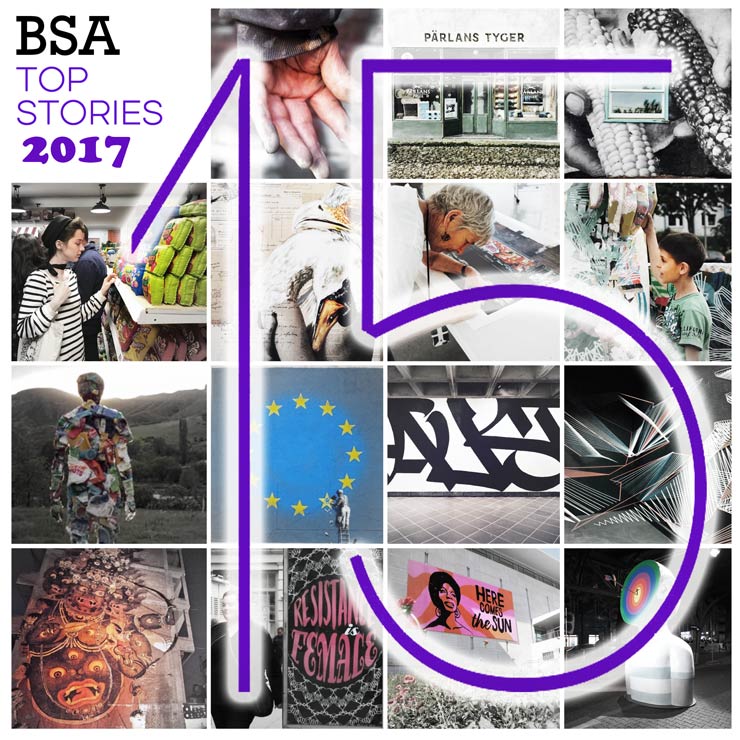
Berlin, Kathmandu, Santa Fe, Brooklyn, Sweden, London, New York, the country of Georgia, Raleigh, North Carolina. The favorite stories of BSA readers spanned all of these places this year as we documented this global people’s art movement variously described as Street Art/ graffiti/ urban art. We put it out there daily and you react to it – sharing it on Facebook, Twitter, and Instagram – starting conversations and creating connections.
The topics of these 15 favorite stories run the gamut as well; From Banksy and Brexit, Marxism and Urvanity to a bodega completely made of felt, your voracious appetite was wide ranging. From a well crafted graffiti writing exhibition at a white suburban Pennsylvania college where the tuition is 50K to an attempt to bring reassuring cultural heritage art to the streets of Kathmandu where the museum was destroyed by an earthquake – the extremes and ironies only peaked your interest.
You loved seeing and hearing Martha Cooper getting her first solo exhibition in New York and the mania that queued thousands to see the transformation of a 5 floor bank in Berlin by graffiti writers, Street Artists, installation artists and performers. You care about the earth and its people, like the story of ICY an SOT in the country of Georgia making human sculptures of trash as a critique of globalized waste, and the story of Chip Thomas using his Street Art to draw attention to a traditional Hopi farming technique called “dry farming”.
And in 2017 the resonance of ‘Resistance is Female’ catapulted our story of the illegal campaign of phone booth takeovers to the top 15, showing that a uniquely impactful high-jacking of the advertising streetscape is always going to win fans.
No matter where we went in 2017, BSA readers were always invited to go along with us and discover people and art on the street and in the gallery or the museum whether it was in Scotland, Hong Kong, Berlin, Sweden, Mexico or Tahiti. We captured what we could and interpreted it – and you told us what you liked by re-Tweeting and re-Gramming and re-Facebooking.
From 365 postings over the last year, here are the 15 you liked the most.
No. 15
Marx and Engels Statues Re-Skinned & Re-Located : Various & Gould
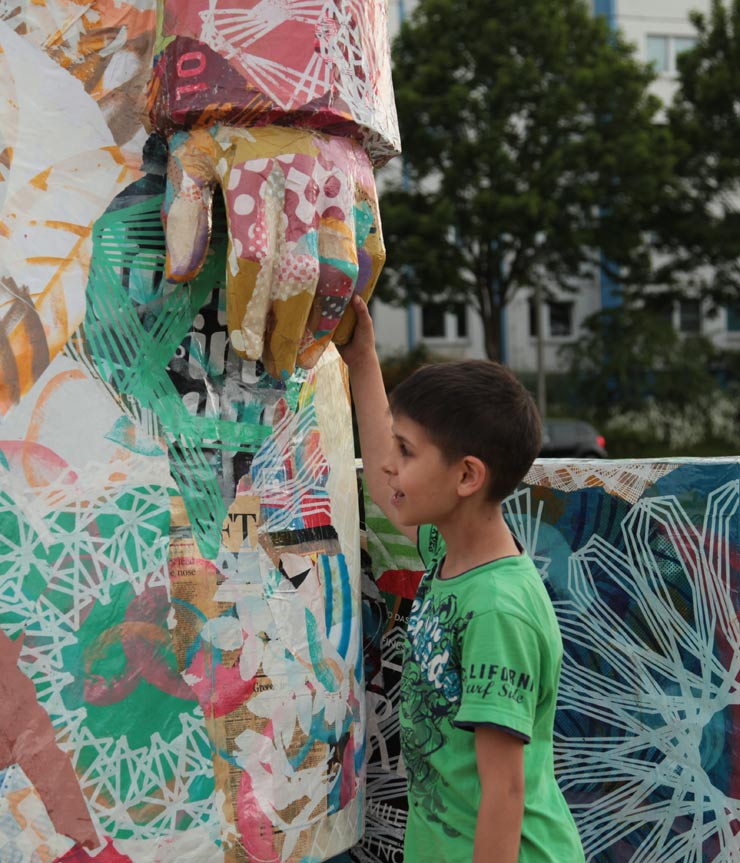
Various & Gould. Berlin, June 2017. (photo © Jaime Rojo)
“Why do you glorify and duplicate these two criminals?! They shouldn’t have a monument at all. Next you’re doing Hitler?”
Various and Gould try to paraphrase some of the comments they received from passersby in a park near the town-hall in centrally located Berlin-Mitte while working on their latest project with a statue of the creators of Marxist theory. Some imagined they were glorifying, others alleged defamation.
“It’s a shame how you treat Marx and Engels!”
Truthfully, this new project in public space that literally copies a monument and then transfers it to another location didn’t have much to do with the capitalist system that creates/allows very rich and very poor people, but it certainly adds stories to the overall experience of Various and Gould.
Various & Gould: Marx & Engels. Continue reading HERE
No. 14
“MADRID ME MATA”: Another Look at “Urvanity”
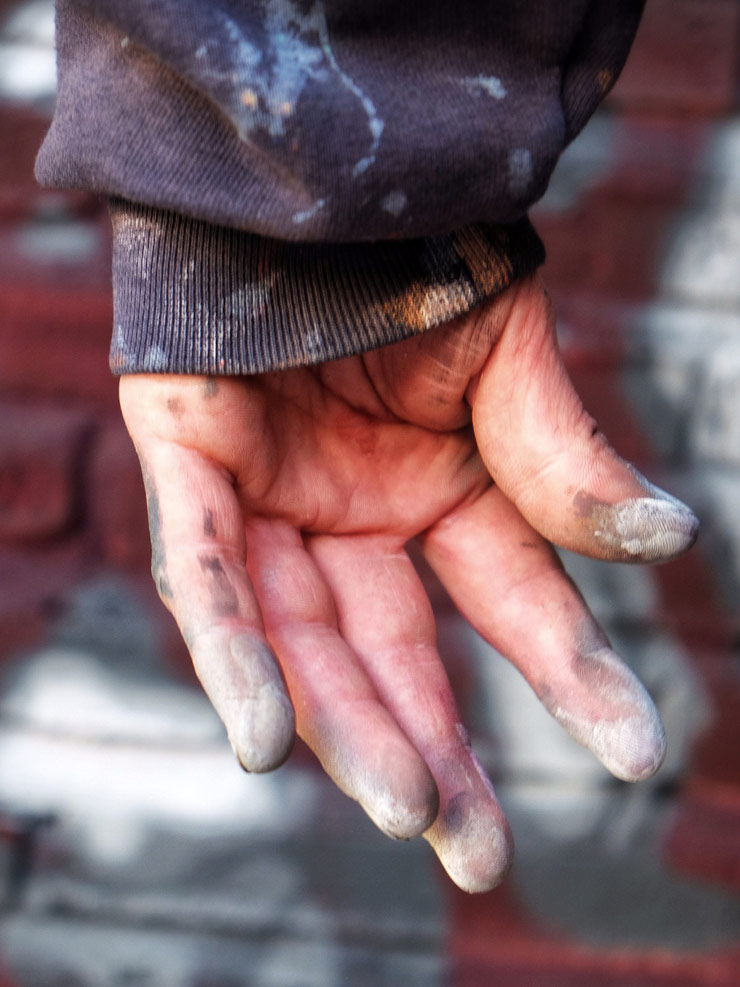
Roc Blackblock Milicians Madrid, Spain. February 2017 (photo © Fer Alcalá FujifilmXT10)
MADRID ME MATA…in a good sense,”
says Fernando Alcalá Losa, the avid Barcelona based photographer of street culture. He doesn’t literally mean that the Spanish capital is deadly, but rather speaks of his devotion to Madrids’ energy, its possibility, its history, its people, and to its art. The torrid affairs of the heart are invariably complicated, as is the evolution of graffiti and Street Art from their outlaw illegal roots to their flirtations and trysts with other forms and venues; murals, in-studio practice, gallery representation, institutional recognition, or commercial viability.
We are pleased that Mr. Alcalá Losa comes to talk to BSA readers today and takes us to Madrid for the new art fair called “Urvanity” to see what he discovers with you, courtesy his words and his lovers’ view behind the camera.
Madrid Me Mata…in a good sense. Continue reading HERE
No. 13
Lucy Sparrow Opens an All-Felt Bodega in NYC : “8 ‘Till Late”
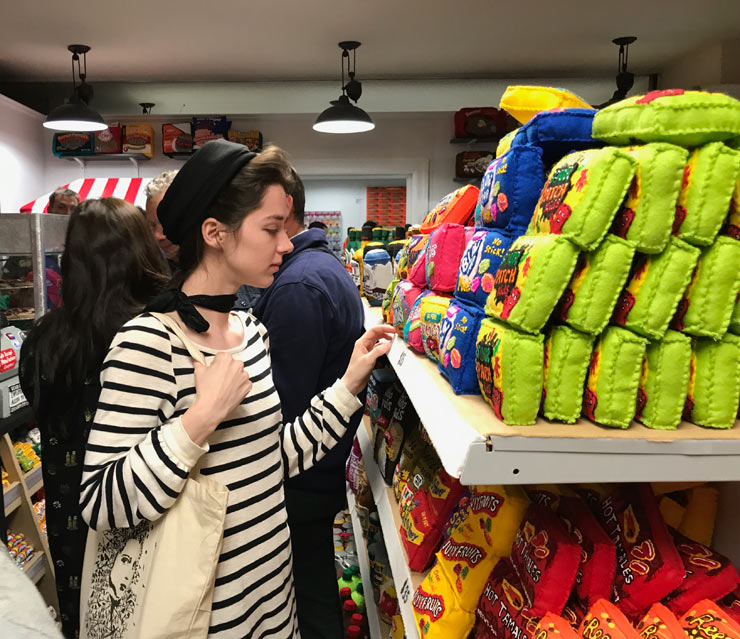
Lucy Sparrow 8 ‘Till Late (photo © Jaime Rojo)
It’s 8 ‘Till Late, artist Lucy Sparrows first all-felt store in New York, and it’s literally just under the Standard Hotel in the Meat Packing district. She’s made 9,000 items over roughly 9 months out of this soft fabric-like craft material – and at first impression it sincerely looks like everything you would have found in a New York bodega in the 1990s aside from the hard liquor, which is actually illegal to sell outside a liquor store in NYC, but relax, its all heartfelt.
“We sell quite a lot of self-help books as well,” chimes in Clare Croome, a cashier.
“Yes! Self-help books! Have you seen them?” says Brooks “They’ve got nothing in them on the pages, they’re just blank.”
Lucy Sparrow 8 ‘Till Late. Continue reading HERE
No. 12
“All Big Letters” Opens, Curated by RJ Rushmore
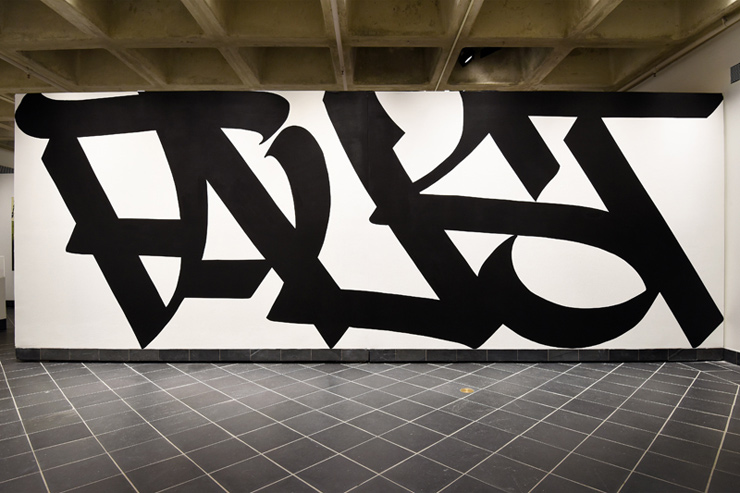
Faust. All Big Letters curated by RJ Rushmore at Haverford College’s Cantor Fitzgerald Gallery. Philadephia, PA (photo © Lisa Boughter)
“I wanted to exhibit the mind of a graffiti writer in a gallery, and make that mindset understandable to your average gallery-goer,” he tells us. “To me, that means appreciating not just the finished piece, but how and why it came to be.”
By showing artists, works, photography, and tools that judiciously span the 50 or so years that mark the era of modern mark-making in the public sphere, Rushmore threads a story line that he hopes a visitor can gain an appreciation for in this art, sport, and quest for fame.
All Big Letters. Continue reading HERE
No. 11
Anonymouse: Miniature Vignettes on the Street for “No Limit” Festival in Boras, Sweden
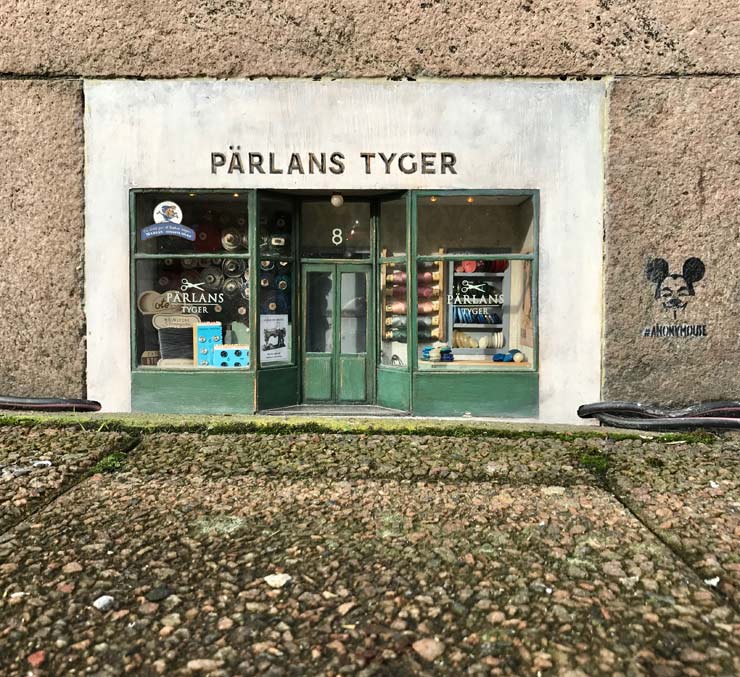
Anonymouse. No Limit Boras 2017. Boras, Sweden. September 2017. (photo © Jaime Rojo)
Miniaturization on the street or in the museum (or in the street museum) causes you to focus on detail, draw closely, to recall your childhood ability to freely invoke a sense of fantasy.
“Since our visitors are mostly nocturnal, our opening hours are quite generous,” the artists known as Anonymous say in reference to their nighttime installations, sometimes glowing with electric light in the lee of a bridge column, or the shadow of a door. They reference the famous Swedish children’s book author Astrid Lindren in their work, and you can easily visualize a small mouse family or a business mouse or a house mouse or church mouse astutely moving through these vignettes, living their important lives.
Possibly one is currently occupied in a back room of one of these installations at the moment but they will be returning presently to greet their new visitor – you, with your big face. Don’t worry, they like you to get up close. They may even provide a magnifying glass for you to get a closer look.
Anonymouse. Minuature Vignettes. Continue reading HERE
No. 1o
Bunnies, Birds, Sexuality and VINZ Feel Free’s “Innocence” in Brooklyn
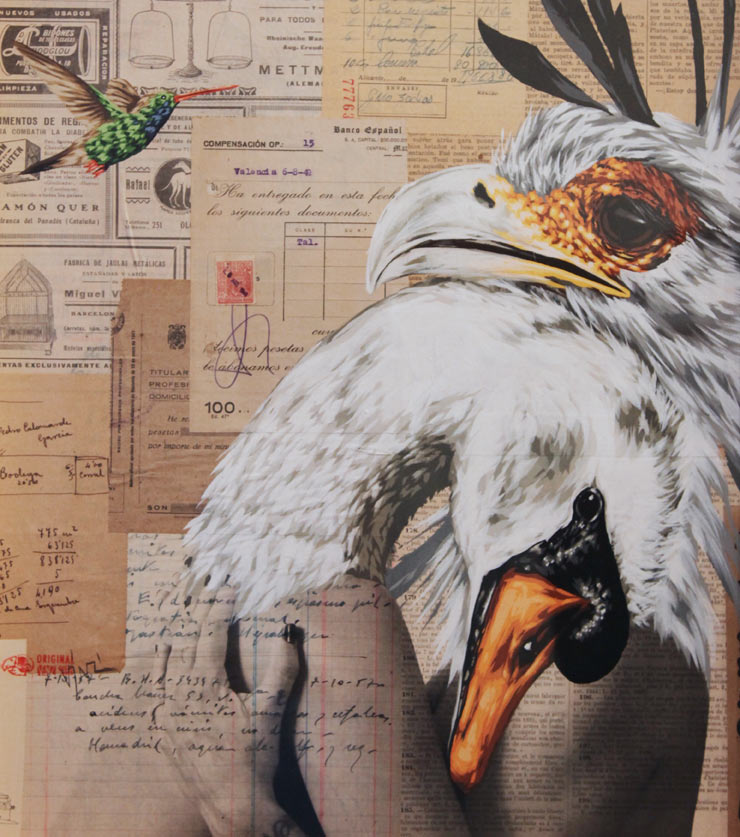
Vinz Feel Free. “Innocence” The Marcy Project. Williamsburg, Brooklyn. November 4th. 2017 (photo © Jaime Rojo)
Birds are associated with freedom, fish remind him of mindless consumerism, and frogs convey authority. He reserves reptiles for soulless soldiers of capital and authoritarian types. And the sudden preponderance of rabbits? Why sexuality and innocence of course.
“Innocence” is the name of the exhibition here curated by BSA and DK Johnston, and Vinz Feel Free has been preparing these works for many months. A project that has included his study of innocence, the show is meant to demarcate such shadings of the concept as to appear only subtly different from one another. To wit:
1. The quality or state of being innocent; freedom from sin or moral wrong.
2. Freedom from legal or specific wrong; guiltlessness.
Vinz Feel Free. “Innocence”. Continue reading HERE
No. 09
Julien De Casabianca, Angry Gods, and Hacking Disaster in Kathmandu
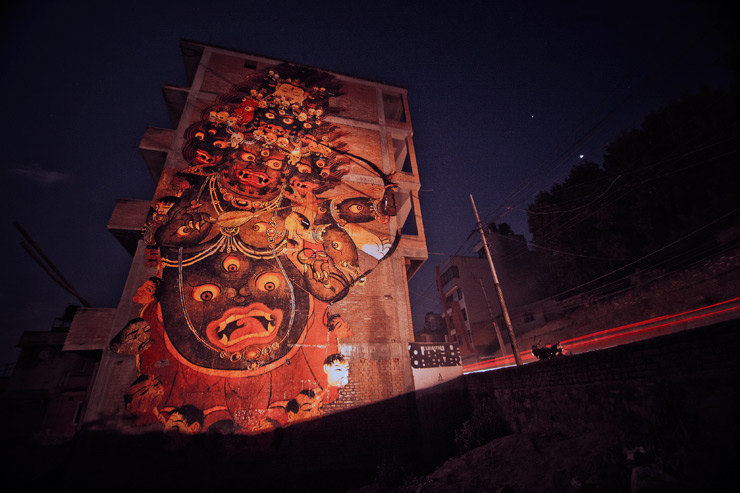
Julien De Casabianca. Outings Project. Kathmandu, Nepal. January, 2017 (photo © Karma Tshering Gurung & Sanam Tamang/ Artudio)
If you are not going into the museum to see art, Julien De Casabianca is happy to bring it out to the street for you. Additionally, if the museum has been closed by an earthquake, he’ll make sure the art gets a public viewing nonetheless.
In Kathmandu recently Street Artist Julien de Casabianca continued his Outings Project by bringing a centuries-old painting outside to the side of the Artudio building in Swoyambhu on Chhauni Hospital Road with the help of Matt Rockwell of the humanitarian hackers group called DisasterHack.
He tells us that the obstacles to getting this piece up seemed insurmountable at times due to the broken social and infrastructural systems in Nepal that still plague people even today, nearly two years since the catastrophic earthquake that killed nearly 9,000 and injured 22,000 more.
Julien De Casabianca/Outings Projects in Kathmandu. Continue reading HERE
No. 08
Rocking “THE HAUS” : A 5-Floor Berlin Bank is Transformed by Artists
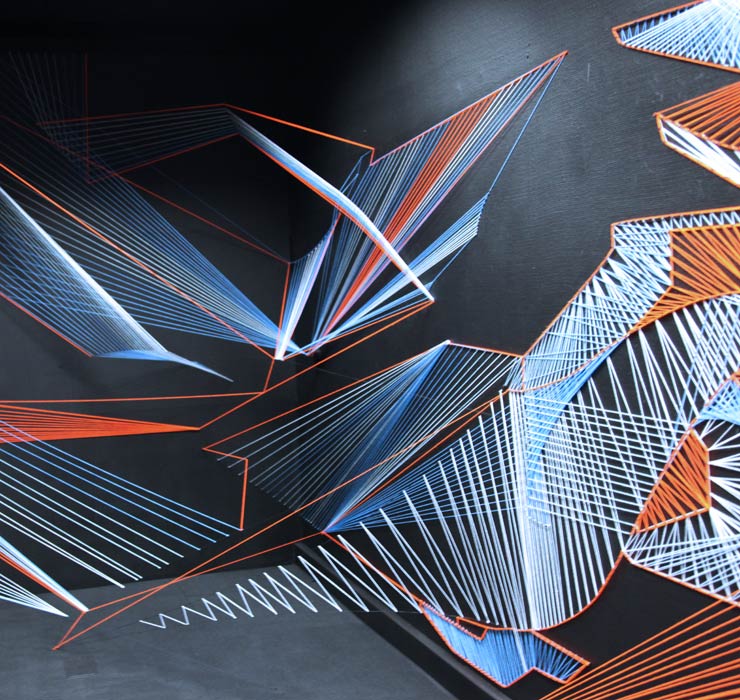
Kaleido. The Haus. Berlin. March 2017. (photo © Jaime Rojo)
“Normally we paint advertising – hand-painted advertising, mostly with cans. So we work all over Germany, with a lot of crews, “ says Kimo, a bearded, bald energetic and sharp witted guy who is lighting up a cigarette in this tattered, beige ex-conference room. That explanation doesn’t prepare you for what you will see in the rooms upstairs.
The floors are piled with unopened paint buckets and brushes and cans and the walls in this organizing office are covered with scotch-taped project timelines, to-do lists, and floor plans of the old bank. Each former office space is plainly labled with names of German Street Artists or graffiti crews, some you recognize, others you don’t. More recent Street Art names are next to classic Graff heads, installation artists mix freely with Optic Artists, photographers, sculptors, even a live moss installation.
Case Maclaim is right next door to Turbokultur with Stohead out in the hall on floor 1. El Bocho and Emess are in small rooms to either side of 1UP on the 3rd. Herakut in a corner room numbered 506 is right next to Nick Platt and Paul Punk in 505.
Rocking The Haus. Continue reading HERE
No. 07
Working the Cornfields on a Santa Fe Facade with Jetsonorama
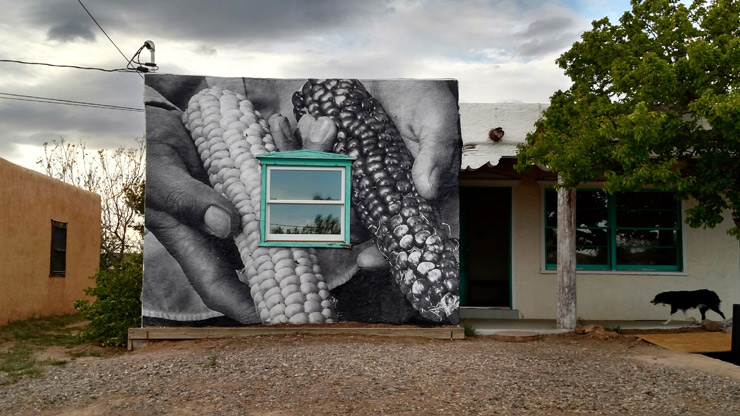
Chip Thomas. Santa Fe, New Mexico, Earth Day 2017. (photo © John Donalds)
18 year old Hawthorne Hill has learned the traditional Hopi farming technique called “dry farming” from his mom, according to Jetsonorama, and he places seeds in shallow holes, while his sister Metzli creates rows of wind blocks using nearby brush.
The photos are taken on Second Mesa on the Hopi nation, but the artist brings them here to Santa Fe as part of a project he’s doing with Biocultura Santa Fe.
A project originally conceived of as part of Earth Day, with a focus on where our food comes from and traditional farming methods, its good to think of who works to bring food to your table.
Working The Cornfields. Continue reading HERE
No. 06
“A Real Turning Point” : Sculptures on the Art Mile at Urban Nation Museum For Urban Contemporary Art
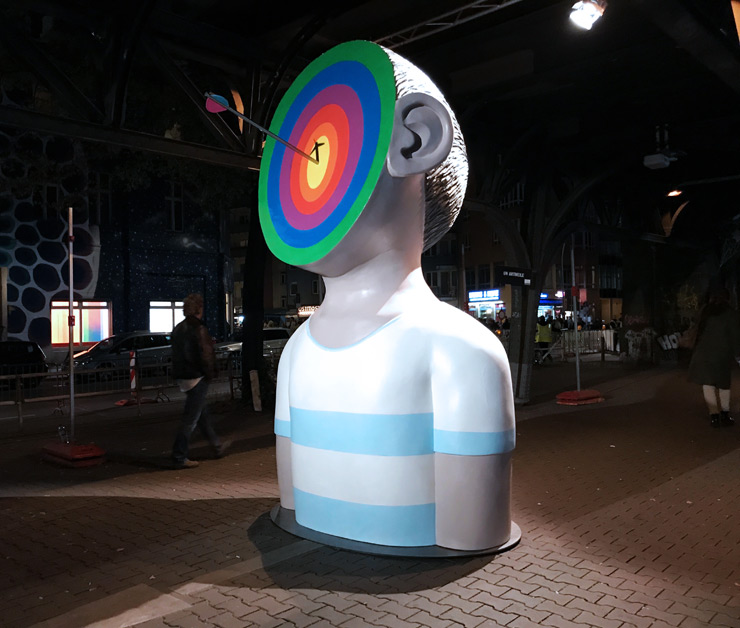
Seth Globepainter. Art Mile. Urban Nation Museum For Urban Contemporary Art. (photo © Jaime Rojo)
“I think it’s a real turning point as far as seeing three dimensional things,” says Street Artist and fine artist Ben Frost while hand painting text on the side of the large facsimiles of pharmaceutical boxes that he’s creating for the UN Art Mile. “I think sculptures and installations have been paving a way forward for Street Art.”
In fact sculpture and all manner of three dimensional installations as Street Art have been a part of the current century for sure, from the variety of lego and yarn artists to the soldiered steel tags of REVS and eco-bird houses of XAM and small little men made of wood by Stikman – among many others.
For the opening of UN this weekend, the Urban Nation Museum of Urban Contemporary Art in Berlin this week, a curated selection of artists working in such dimensions were invited to create substantial pieces – including video installation, mobile, interactive, the purely static. Enjoy the variety of works by Street Artists who are working today.
Urban Nation Berlin. Art Mile. Continue reading HERE
No. 05
“Resistance is Female” Takes Over Phone Booths in New York
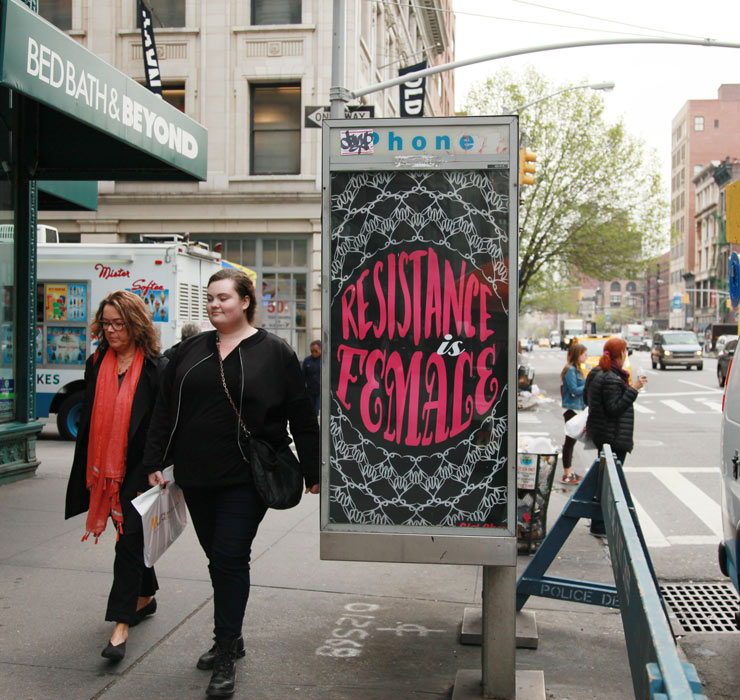
Gigi Chen for (photo © Jaime Rojo)
So it makes perfect sense that a new grassroots takeover of telephone booth advertising in New York is a campaign called, “Resistance is Female”. Organizers and artists say that the ad takeover project is putting out a message that corporate controlled media seems to be quelling: keep fighting, keep speaking up, persevere.
The artists have put up a couple of dozen or so new art pieces in places where typecast women typically sell shampoo or fashions: a high-jacking of the advertising streetscape which the French and the Situationists would have called détournement in earlier decades.
Resistance Is Female. Continue reading HERE
No. 04
Street Artist OLEK and Volunteers Create NINA SIMONE Tribute in Raleigh, NC
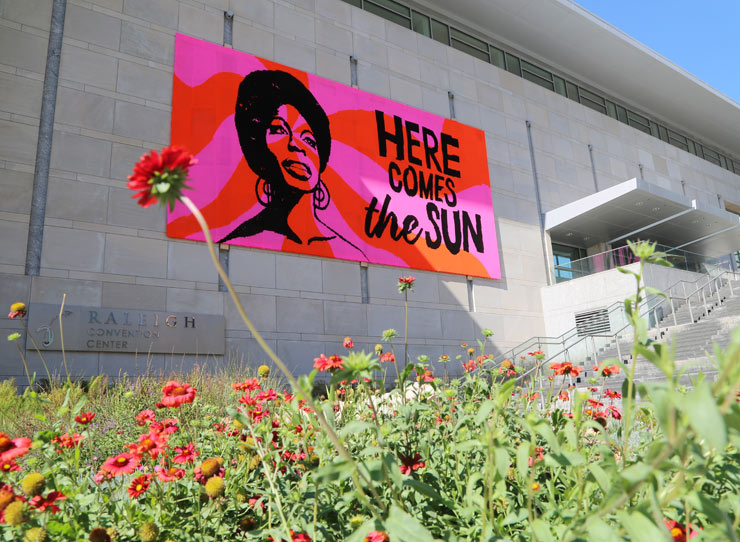
Olek. Nina Simone “Here Comes The Sun” Love Across The USA. Raleigh, North Carolina. October 2017. (photo © courtesy Olek)
Susan B. Anthony, Harriet Tubman, Nina Simone; Three of the women whom Street Artist Olek would like us to remember from U.S. history, and who have been recently featured in public crochet portraits. Her most recent portrait done with help from the community brings art made by the public to the public in a country-wide project called “Love Across the USA”.
Sparked a year ago leading up to the US national election where a woman was on the ballot, Olek says that despite the negativity that followed, “it inspired me to create a project that would celebrate the accomplishments of women, many of whom had been forgotten throughout U.S. history.”
Today we go to Raleigh, NC to see the most recent banner of Nina Simone crocheted by Olek and a small army of volunteers. https://en.wikipedia.org/wiki/Nina_Simone, the American singer, songwriter, pianist, arranger, and activist in the Civil Rights Movement.
Olek. Here Comes The Sun. Continue reading HERE
No. 03
Icy & Sot and a Man of Trash in Tbilisi, Georgia
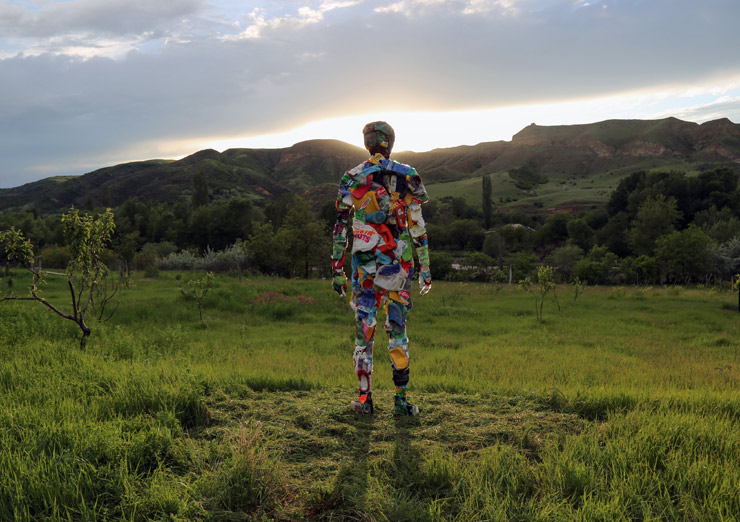
Icy & Sot. “Human reflection on nature”. Tbilisi, Georgia. May 2017. (photo © Icy & Sot)
15 centuries old, Tbilisi may not last as long as this garbage man sculpture by Street Artists Icy & Sot.
“It took us only 10 minutes to collect all this trash because there was so much of it – including American brands – in the river by this village,” says Icy as he tells us about the trip he and his brother Sot made last month. A gorgeous and historically diverse city of 1.5 million people, Tbilisi reflects art, architecture, trade and culture that have given the Georgian capital a reputation as a crossroads for Europe and Asia.
During their stay with the Art Villa Garikula, a self organized community contemporary art center begun Tbilisi born painter and educator, Karaman Kutateladze in 2000, Icy and Sot did two pieces and an ad takeover that reflect the global problems posed by a consumer culture sold by corporations with little concern for its impact long term.
Icy & Sot. Human reflections on nature. Continue reading HERE
No. 02
“Martha Cooper” Solo Exhibition Reveals Many Unseen “Action Shots”
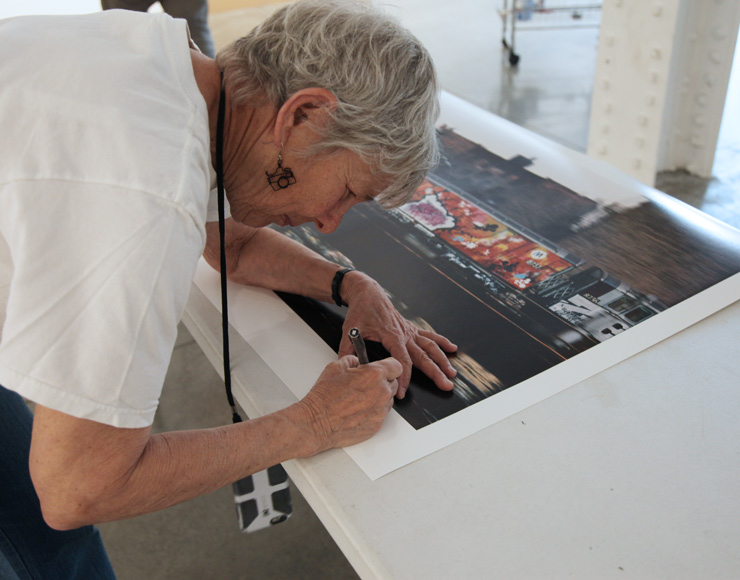
Martha Cooper signing the print of Futura 2000 whole car “Break”, Steven Kasher Gallery. (photo © Jaime Rojo)
An intrepid photographer who has launched a million dreams (and perhaps a few thousand careers) in graffiti and Street Art with her photography that captured crucial and seminal aspects of our culture that others overlooked.
That is just one way of seeing this brand new collection of images by Martha Cooper that is spread across one wall featuring artists at work, sometimes intimately. Here is where you see 102 individual shots of artists at work, a stunning testament to the range of art-making techniques that are practiced in the public realm, as well as a testament to the passion and curiosity of the woman behind the lens.
For Ms. Cooper’s first solo photography show in New York, Steven Kasher Gallery is featuring 30 new editions of her legendary street art photographs, the ones that have burned themselves into the collective memory of New York and of our streets in the 1970s and 1980s. While her photographs in the 1984 seminal “Subway Art” and her early Hip Hop street shots may be what she is most known for by artists and collectors and fans in cities around the world to which she travels, the new exhibit also contains more than a foreshadowing into the vast collection of important images she has not shown to us.
Martha Cooper Solo Show. Continue reading HERE
No. 01
Banksy Hits Brexit With New Piece, MaisMenos & BLU Used EU Flag Earlier
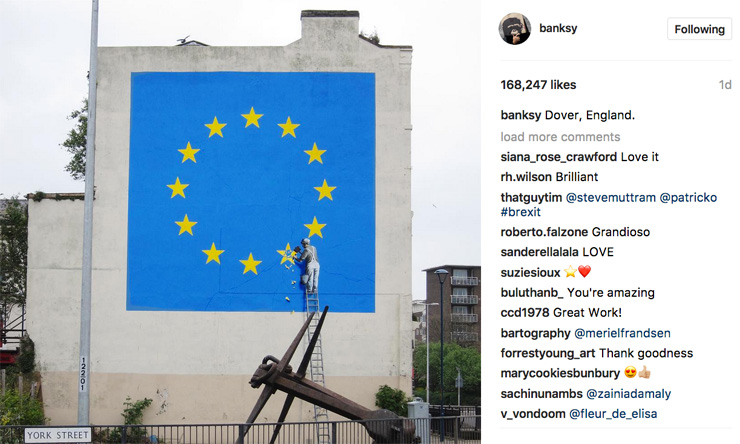
Banksy. Dover, England. Photo @banksy Instagram
The appearance of a new mural by Banksy in Dover, England caught the attention of many followers on his Instagram account and the mass media folks quickly reported on the new piece that comments on the current state of the EU.
10 months since the Brexit vote, the anonymous artist has created a thoughtful piece marking the crack in the European Union, depicting a white male worker on a ladder chipping away one of the stars on the EU flag, a fissure produced by the action reaching upwards and outwards toward the others.
Banksy Brexit. Continue reading HERE
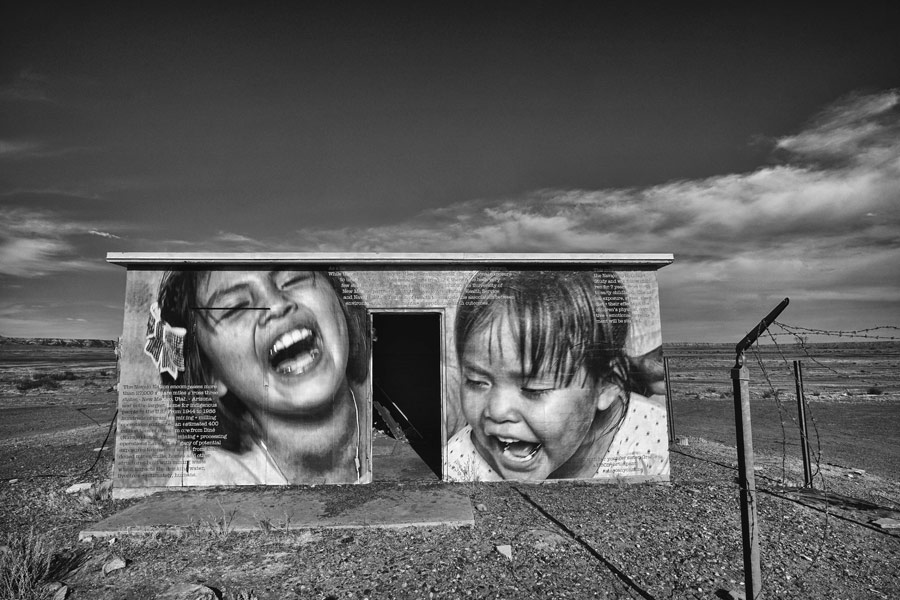
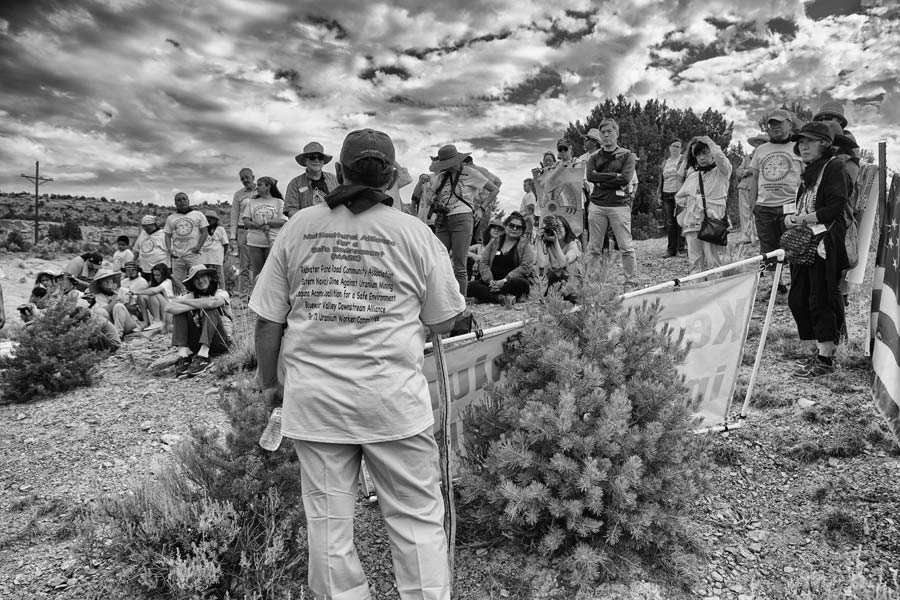
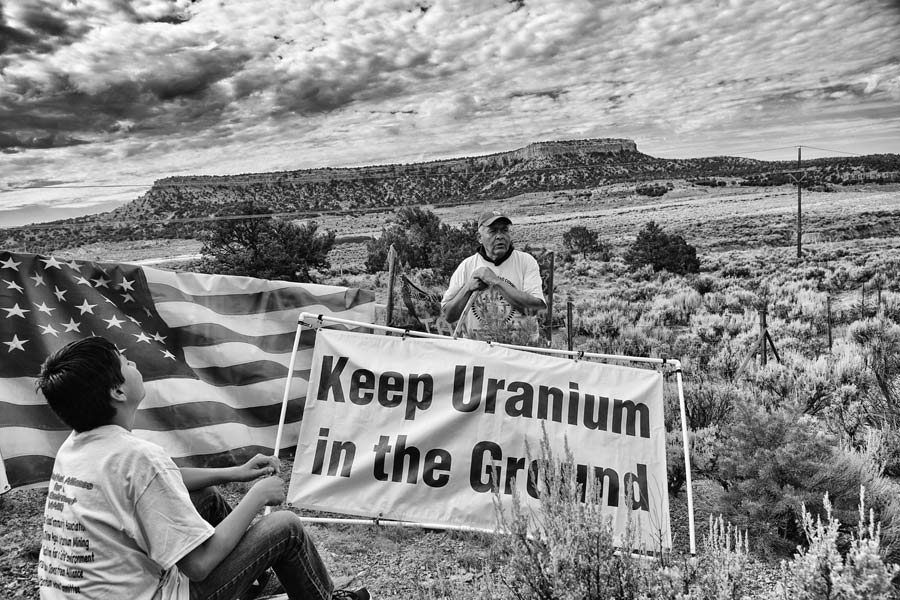
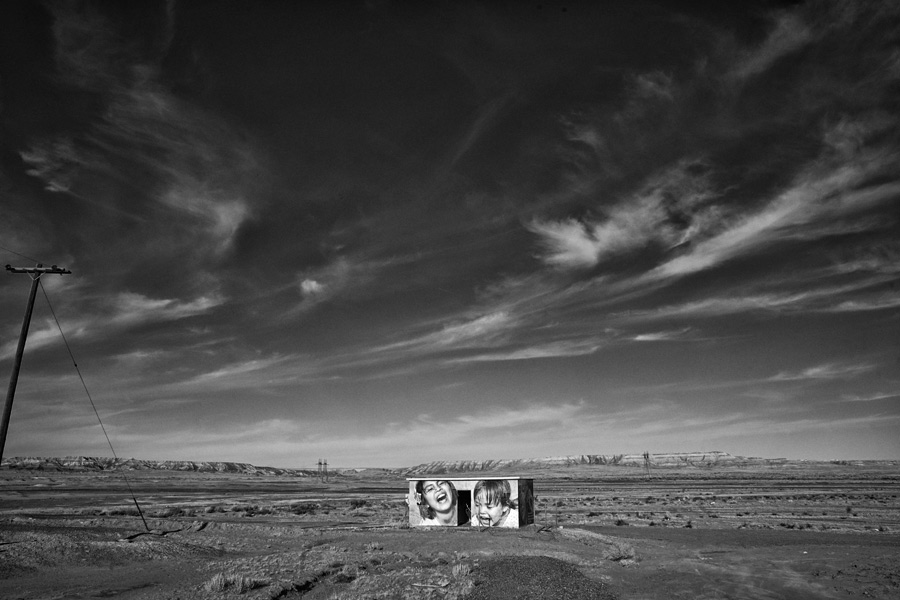
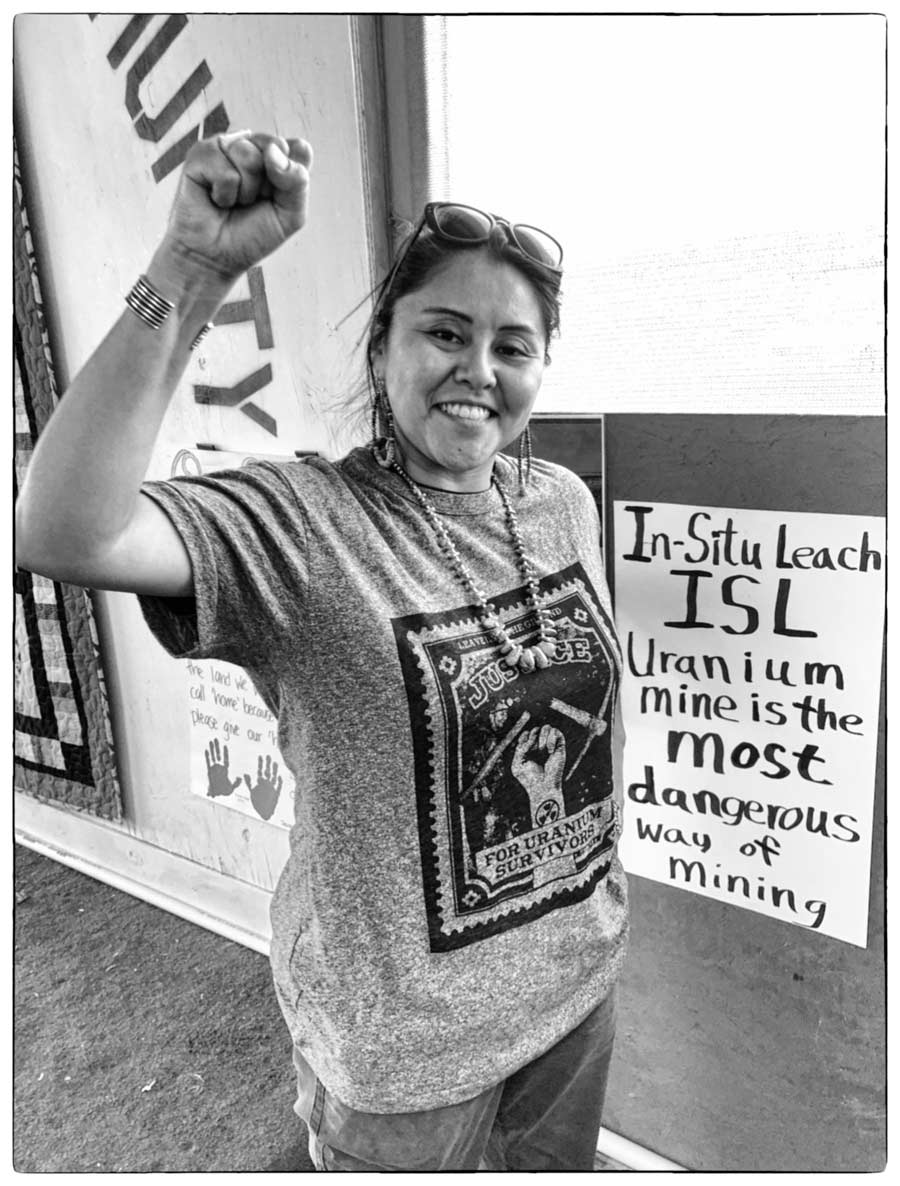
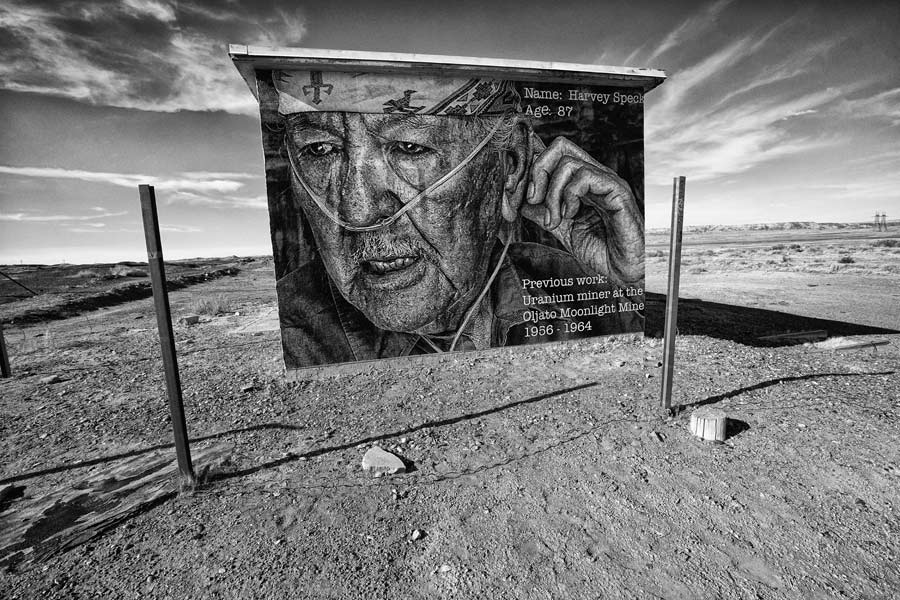
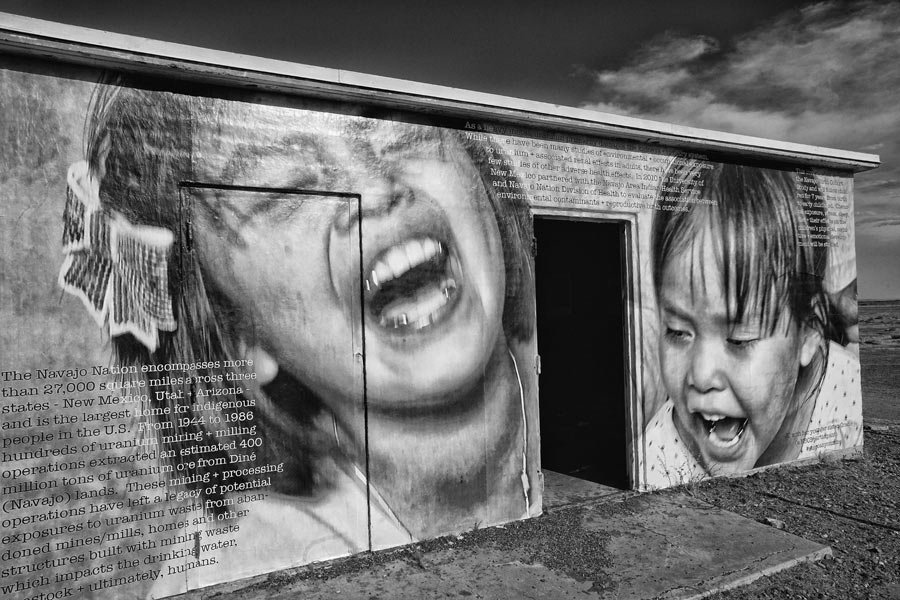
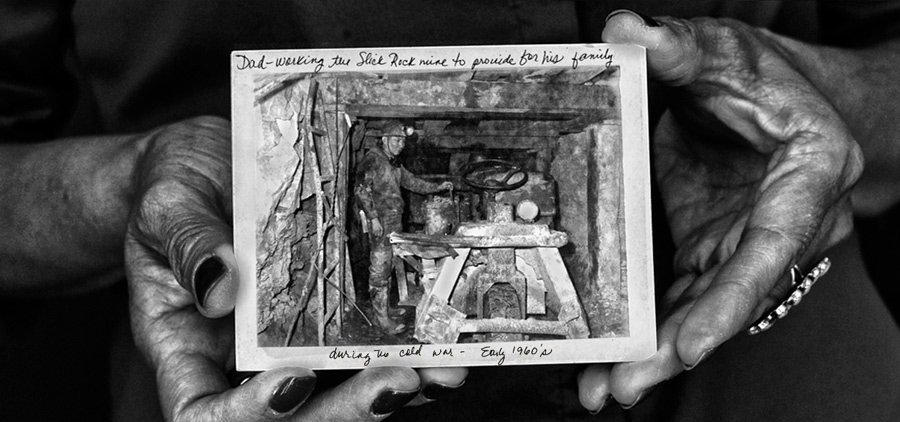
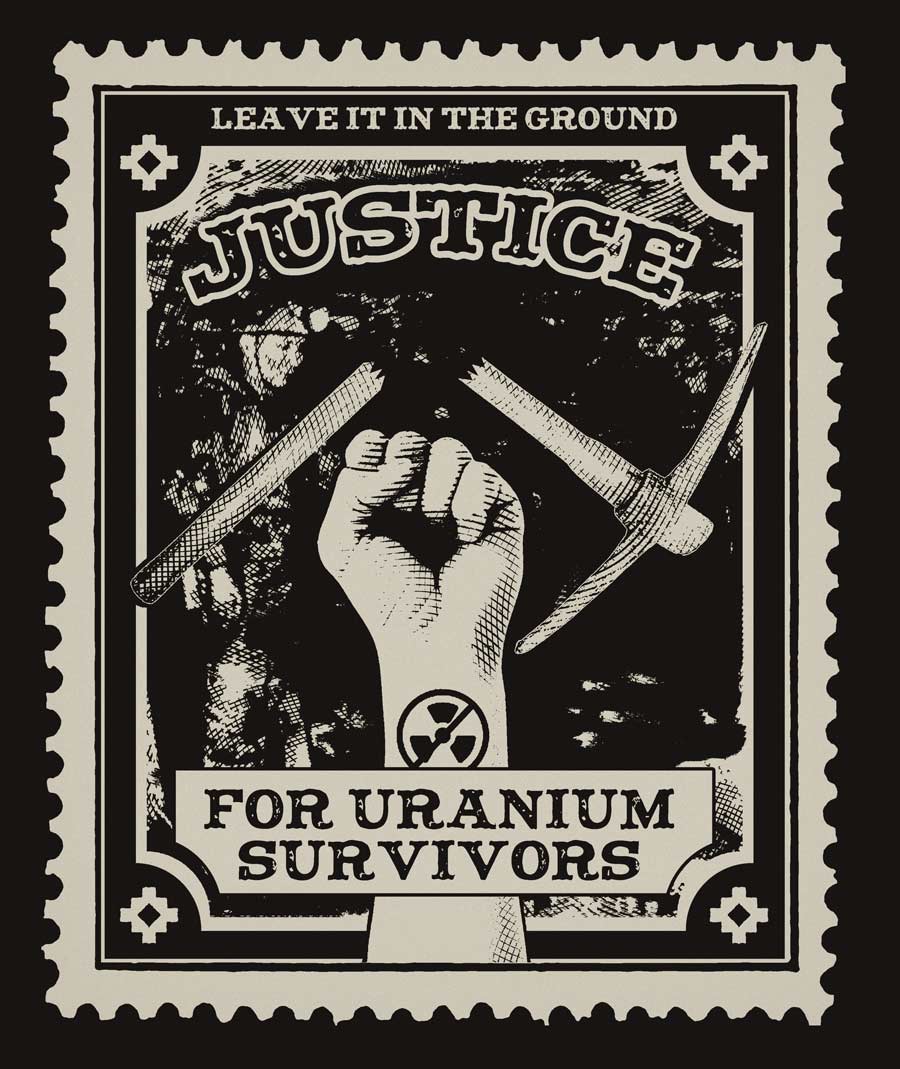
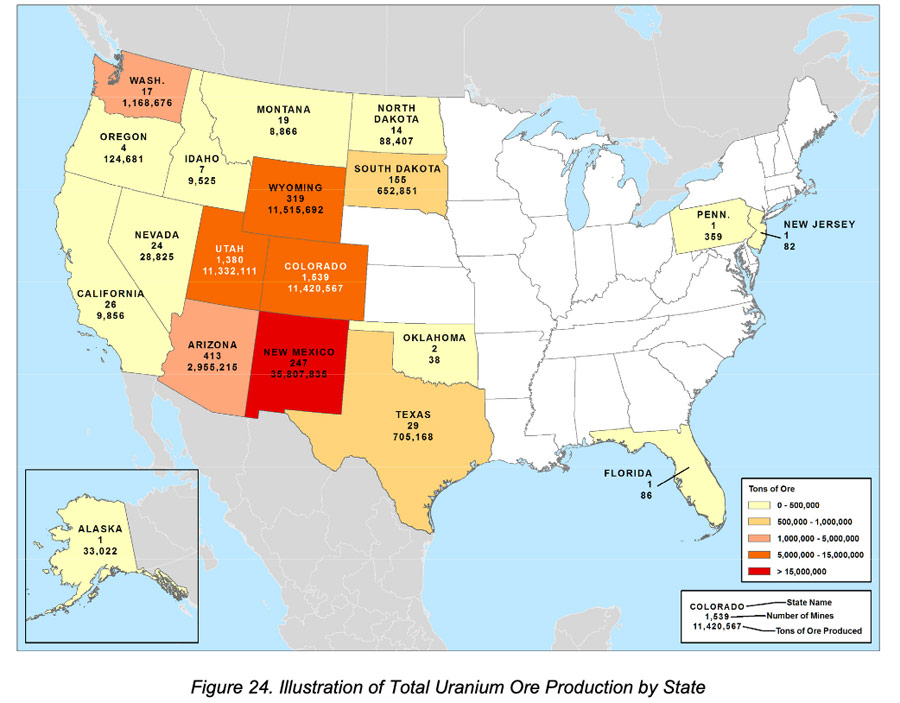
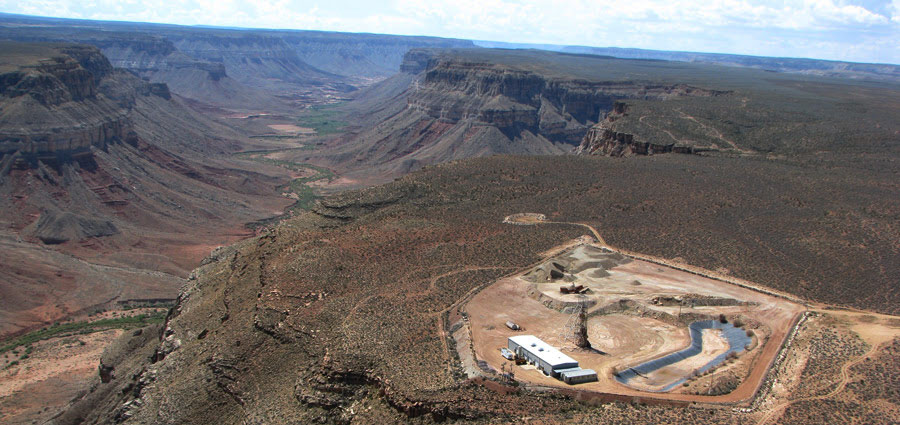
 BROOKLYN STREET ART LOVES YOU MORE EVERY DAY
BROOKLYN STREET ART LOVES YOU MORE EVERY DAY